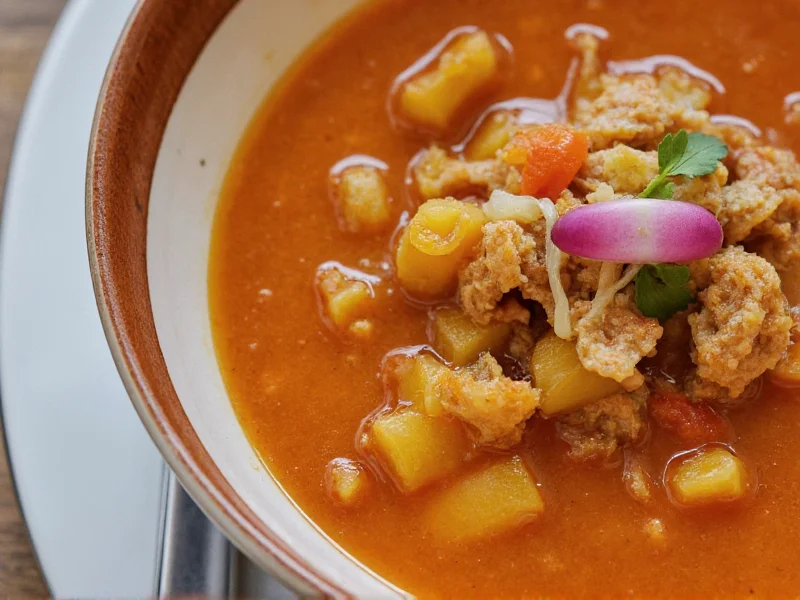When exploring traditional Asian culinary practices, cock soup represents a time-honored preparation method that transforms mature roosters into nourishing broths. This distinctive soup differs significantly from standard chicken soup due to the biological characteristics of mature male chickens, which contain higher concentrations of certain nutrients and require specialized preparation techniques.
Cultural Significance Across Asian Traditions
Cock soup has deep roots in traditional Chinese medicine and culinary practices, where it's considered a yang-boosting food that helps restore vitality and balance in the body. In Vietnamese cuisine, gà ác tiềm (black chicken soup) often incorporates rooster meat with medicinal herbs for postpartum recovery and general wellness. Korean dak-hwangchung-tang features rooster soup with ginseng as a restorative dish during hot summer months.
Nutritional Composition and Scientific Perspective
Research indicates that rooster meat contains higher protein density and different amino acid profiles compared to younger chickens. The extended cooking process extracts valuable compounds including:
- Collagen and gelatin from connective tissues
- Minerals like calcium and magnesium from bones
- Essential amino acids including glycine and proline
- Small amounts of testosterone and other hormones
| Nutrient | Cock Soup (per 100g) | Regular Chicken Soup (per 100g) |
|---|---|---|
| Protein | 8.2g | 6.5g |
| Collagen | Significantly higher | Moderate |
| Mineral Density | Higher calcium, magnesium | Lower mineral concentration |
| Cooking Time | 3-6 hours | 1-2 hours |
Traditional Preparation Methods
Authentic cock soup preparation follows specific protocols that maximize both flavor and potential health benefits. The process typically involves:
- Selecting mature roosters between 1-2 years old for optimal nutrient profile
- Thorough cleaning and preparation, often including singeing to remove fine feathers
- Initial blanching to remove impurities and blood residue
- Slow simmering for 3-6 hours with medicinal herbs like ginseng, astragalus, or goji berries
- Skimming fat and impurities throughout the cooking process
- Final seasoning with minimal salt to preserve natural flavors
Professional chefs emphasize that rushing the cooking process results in tough meat and inferior broth quality. The extended simmering time allows for complete breakdown of connective tissues, creating a rich, gelatinous texture that distinguishes authentic cock soup from ordinary chicken preparations.
Health Considerations and Scientific Evidence
While traditional medicine attributes numerous benefits to cock soup, modern research provides more nuanced insights. Studies suggest potential benefits including:
- Improved joint health due to high collagen content
- Enhanced recovery from illness or surgery
- Support for bone density maintenance
- Potential immune system modulation
However, scientific evidence supporting some traditional claims remains limited. Nutritionists recommend viewing cock soup as part of a balanced diet rather than a standalone remedy. Individuals with gout or high uric acid levels should consult healthcare providers before regular consumption due to the soup's purine content.
Regional Variations and Modern Adaptations
Culinary traditions have developed distinctive cock soup variations across Asia:
- Chinese medicinal cock soup incorporates 8-12 different herbs targeting specific health concerns
- Vietnamese black rooster soup uses silkie chickens with dark meat and bones
- Korean samgyetang features whole young roosters stuffed with glutinous rice and ginseng
- Thai tom kha gai sometimes uses rooster meat in coconut-based broths
Modern adaptations include pressure-cooking methods that reduce preparation time while maintaining nutritional integrity, and organic/free-range rooster sourcing for enhanced flavor and quality.
Practical Considerations for Home Preparation
For those interested in preparing authentic cock soup at home, several practical considerations ensure optimal results:
- Source roosters from specialty Asian markets or farms that raise birds specifically for soup
- Use ceramic or clay pots for traditional preparation, which distribute heat evenly
- Maintain gentle simmer rather than vigorous boiling to prevent cloudiness
- Add herbs at appropriate stages to maximize extraction of active compounds
- Cool and refrigerate overnight to easily remove congealed fat before final serving
Many experienced cooks recommend making cock soup in larger batches and freezing portions, as the flavor often improves with time and the lengthy preparation justifies larger quantities.
What is the difference between cock soup and regular chicken soup?
Cock soup uses mature roosters (typically 1-2 years old) rather than younger chickens. The meat from mature roosters is tougher and requires longer cooking times (3-6 hours versus 1-2 hours), resulting in a richer broth with higher collagen content. The flavor profile is more intense, and traditional preparations often include specific medicinal herbs not commonly used in regular chicken soup.
Are there scientifically proven health benefits of cock soup?
Research indicates cock soup contains higher concentrations of collagen, gelatin, and certain minerals compared to regular chicken soup. These components may support joint health and provide amino acids beneficial for tissue repair. However, many traditional health claims require more rigorous scientific validation. Nutritionists generally view it as a nutritious addition to a balanced diet rather than a specific medical treatment.
How long should cock soup be cooked for optimal results?
Traditional preparation requires simmering for 3-6 hours to properly tenderize the tougher meat of mature roosters and extract maximum nutrients from bones and connective tissues. Pressure cooking can reduce this time to 1-2 hours while maintaining quality. The soup is ready when the meat easily separates from the bones and the broth develops a slightly gelatinous texture when cooled.
Can women safely consume cock soup?
Yes, women can safely consume cock soup. While traditional beliefs sometimes associate rooster soup with masculine energy, modern nutrition science shows no gender-specific contraindications. In many Asian cultures, it's commonly consumed by women for postpartum recovery. As with any food, individual health conditions should be considered, and those with specific medical concerns should consult healthcare providers.











 浙公网安备
33010002000092号
浙公网安备
33010002000092号 浙B2-20120091-4
浙B2-20120091-4